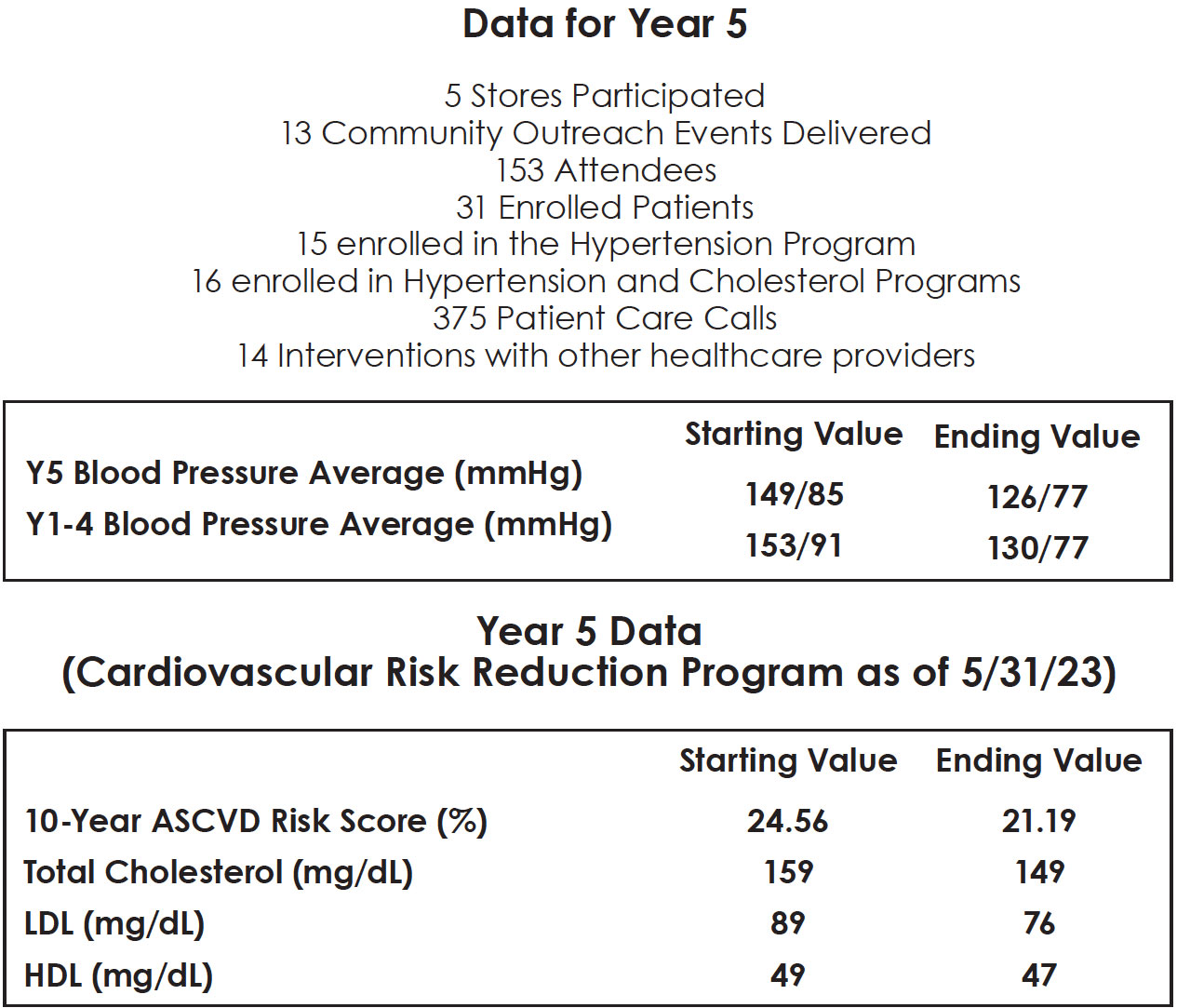South Dakotans Learn About the Risks of Cardiovascular Disease Through a Continued Partnership Between the Community Pharmacy Enhanced Service Network of South Dakota and the South Dakota Heart Disease and Stroke Prevention Program: Year 5 of the Cardiovascular Risk Reduction Program
Summary
In Year 5, participating pharmacies and pharmacists enjoyed getting out into their respective communities to meet community members in a comfortable informal setting to discuss cardiovascular risk and risk reduction programs. Additionally, particpating pharmacists enjoyed using clinical decision-making skills to evaluate a patient’s total risk of experiencing a cardiovascular event in the next 10 years.
Finally, often underutilized as healthcare providers, participating pharmacists also appreciated the option to deliver targeted disease state management programs such as lipid and hypertension management programs to meet their patients’ unique healthcare needs.
Challenges / Barriers
Four years ago the Community Pharmacy Enhanced Services Network of South Dakota (CPESN SD) partnered with the South Dakota Department of Health Heart Disease and Stroke Prevention Program (HDSPP). The partnership has evolved from helping patients with uncontrolled hypertension in years one and two to a multifaceted approach to reducing cardiovascular risk.
Beyond hypertension however, it is well established that increased age, race, sex, smoking, elevated lipids, and diabetes can also increase a patient’s cardiovascular disease risk, stroke risk, and myocardial infarction risk. To address factors beyond uncontrolled hypertension, in Year 3, the Cardiovascular Risk Reduction Program (CVRRP) was designed to lower cardiovascular risk in South Dakota residents by offering both lipid and hypertension management programs.
Solutions
For the fifth year of the program, participating pharmacists reached out to local organizations such as Lion’s Club, senior activity centers, and local clinics and delivered 30 minute presentations. The presentations highlighted cardiovascular disease risk factors and informed community members and caregivers about the cardiovascular risk programs offered in their respective pharmacies.
Community or pharmacy identified program participants were screened for hypertension and their individual risk of having a cardiovascular event (stroke or myocardial infarction) in the next 10 years (ASCVD 10 Risk Score).
Upon ASCVD risk analysis and clinical pharmacist discretion, patients were enrolled in a hypertension management program, lipid management program, or both (similar to previous years).
The goal of each program focused on lifestyle interventions, medication discussion, and disease state education to help lower a patient’s 10-year ASCVD Risk Score to a safer level or help patients reach their American Heart Association recommended blood pressure goal.
Results
To deliver cardiovascular risk reduction programs to additional participants, pharmacists began recruiting community members by meeting residents in a casual setting at a local level. Participating pharmacists delivered informal presentations about a variety of cardiovascular related topics at community gatherings such as public events, senior activity centers, and spiritual centers as a way to bring awareness of cardiovascular risk and the corresponding pharmacy-delivered cardiovascular risk reduction programs to help reduce their risk of heart attack or stroke.
During Year Five, five stores participated in the program and delivered 13 Community Outreach Events to over 150 attendees. There were 31 enrolled participants. 15 were enrolled in the Hypertension Program and 16 were enrolled in both the Hypertension and Cholesterol Programs. There were 375 Patient Care Calls completed and 14 Interventions with other healthcare providers.
Reductions in systolic and diastolic blood pressures were comparable to previous year results.
For participants that have completed the program as of 5/31/23, we are excited to see: 1) Reductions in systolic and diastolic blood pressure values comparable to previous years, 2) Reductions in LDL cholesterol, 3) Increases in HDL cholesterol, and 4) Reductions in 10-year ASCVD Risk score.

Lessons Learned
When participants are in an infomal setting, such as their local senior activity center, they are comfortable discussing their health care needs and ways to improve their care.
Year five of the program also demonstrated that the cardiovascular risk reduction programs can be delivered to participants that may not necessarily be regular patients of the community pharmacy in which the programs are being delivered.
Future Decisions
Years 2-5 of the program demonstrated community pharmacy delivered cardiovascular risk reduction programs are successful in lowering patients’ blood pressure, cholesterol, anc ASCVD Risk factors in existing pharmacy patients as well as physician referred patients. However, there are still many in the community that would benefit from the cardiovascular risk programs, but may not be aware of the programs or how to utilize. Therefore in the upcoming years, CPESN SD is preparing to reach out to a local community health clinic about opportunities for collaboration. Ideally several healthcare shortcomings can be overcome through our efforts including addressing social determinants of health, improving access to cardiovascular risk reduction programs for vulnerable populations, and utilizing all members of the healthcare team including community health workers. Once implemented at an individual store, this model will serve for other pharmacies across the state to partner with their local clinics to continue expanding program access to other South Dakotans that would benefit from the cardiovascular risk reduction programs.